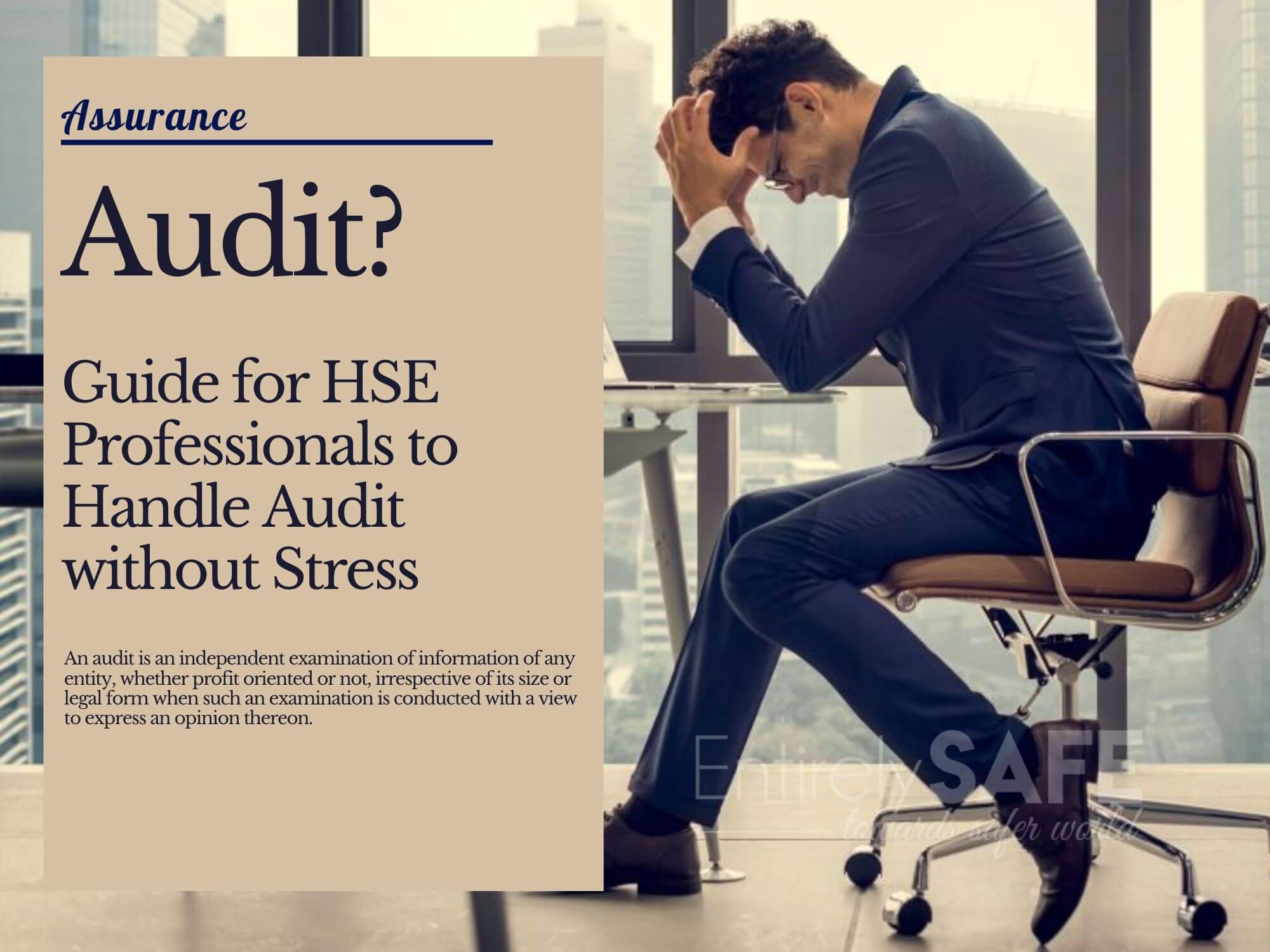Navigating the Audit: Guide for HSE Professionals to handle it w/o Stress

As an HSE professional, handling an external audit can be a challenging and stressful experience. However, with the right approach, it can also be an opportunity to demonstrate the company’s commitment to HSE and to identify areas for improvement. This article will provide a step-by-step guide for handling an external audit professionally, without stress. Whether you are a seasoned HSE professional or are new to the role, this guide will help you to prepare, navigate, and succeed during the audit process.
What is this ‘External Audit’ thing?
External audits in HSE are evaluations conducted by an independent, third-party auditor. The auditor assesses the organization’s health, safety, and environmental management systems, processes, and practices to determine compliance with relevant laws, regulations, and industry standards, and to identify areas for improvement.
The outcome of an external audit can have a significant impact on an organization’s reputation and credibility. A successful audit outcome can demonstrate the organization’s commitment to HSE, and improve its competitiveness in the market. On the other hand, a poor audit outcome can result in negative consequences, such as increased regulatory scrutiny, loss of business, and damage to reputation. It is therefore critical for HSE professionals to handle the audit process professionally to ensure a successful outcome and maintain a positive relationship with the auditor.
Audit date is approaching ! Don’t panic, we have you covered!
It is normal for HSE professionals to feel some stress and anxiety when an external audit is coming up, however, it is important to remember that panicking will not help the situation. Instead, the professional should take a measured and proactive approach to the audit, following the steps outlined in the article. By preparing thoroughly, maintaining a positive attitude, and being transparent and open to feedback, the professional can demonstrate the company’s commitment to HSE and help to achieve a successful outcome.
- Reviewing company’s HSE policies and procedures
Before an external audit, it is important to review the company’s HSE policies and procedures to ensure they are up to date and in line with industry standards and regulations. The HSE professional should also familiarize themselves with the auditor’s expectations and requirements to ensure that the company is prepared to meet them. - Gathering relevant documentation and records
The HSE professional should gather all relevant HSE-related documentation and records, including health and safety incidents, environmental incidents, training records, and emergency response plans. This information should be organized and easily accessible to the auditor during the audit. - Identifying areas of improvement
The HSE professional should identify areas where the company’s HSE performance can be improved. This could include areas such as reducing health and safety incidents, improving environmental performance, or improving the efficiency of HSE processes. By identifying these areas in advance, the HSE professional can ensure that the company is prepared to address any concerns that may be raised during the audit. - Assigning tasks and responsibilities to team members
To ensure a smooth and efficient audit process, the HSE professional should assign tasks and responsibilities to team members. This could include tasks such as assisting the auditor with document and record retrieval, providing information on specific HSE processes, and ensuring that the auditor has access to the necessary facilities and equipment. By assigning these tasks, the HSE professional can ensure that the audit is handled professionally and efficiently, reducing the potential for stress.
Audit has started, be Positive and Professional
During the audit, it is important for the HSE professional to maintain a positive and professional attitude. This includes being respectful, cooperative, and responsive to the auditor’s requests. The professional should also be able to effectively communicate with the auditor, answering questions and providing information in a clear and concise manner. Maintaining a positive and professional attitude can help to establish a good working relationship with the auditor and reduce the potential for stress.
The HSE professional should provide clear and accurate information to the auditor, and be prepared to answer any questions that may arise. This includes providing data and documentation, as well as explaining the company’s HSE policies, procedures, and processes. Providing clear and accurate information can help to build trust and credibility with the auditor and ensure a successful outcome.
You should be transparent and open to feedback from the auditor, and be willing to engage in constructive discussions on any findings or recommendations that may be made. This includes being willing to accept constructive criticism and using it as an opportunity for improvement. Being transparent and open to feedback can demonstrate the company’s commitment to HSE and help to establish a positive relationship with the auditor.
Be proactive in addressing any findings or recommendations that may be made during the audit. This includes developing an action plan to address any identified areas for improvement, and implementing corrective actions in a timely manner. Being proactive in addressing findings and recommendations can demonstrate the company’s commitment to HSE and improve its overall performance.
Health and Safety Audit is over, what is next?
- Reviewing the audit report and feedback
After the audit, the HSE professional should review the audit report and feedback, taking note of any findings or recommendations that were made. This review should be thorough and considerate, and should take into account the auditor’s perspective and any areas where improvement can be made. - Developing an action plan to address findings and recommendations
Based on the review of the audit report and feedback, the HSE professional should develop an action plan to address any findings or recommendations. This plan should include specific actions to be taken, responsibilities, deadlines, and any other relevant information. The action plan should be comprehensive and realistic, and should take into account the company’s resources and capabilities. - Implementing the action plan and monitoring progress
Once the action plan has been developed, the HSE professional should implement it and monitor progress. This includes ensuring that the necessary resources are allocated, and that the plan is being implemented according to schedule. The professional should also regularly review the progress of the plan and make any necessary adjustments to ensure that the plan is effective and efficient. - Communicating with the auditor regarding progress and implementation
The HSE professional should communicate with the auditor regarding the progress and implementation of the action plan. This includes providing regular updates on the status of the plan, and discussing any challenges or issues that may arise. By keeping the auditor informed, the professional can demonstrate the company’s commitment to HSE and build a positive relationship with the auditor.
Conclusion
In this article we outlined the steps that an HSE professional can take to handle an external audit professionally, without stress. These steps include preparing for the audit by reviewing company policies and procedures, gathering relevant documentation, and assigning tasks to team members. During the audit, the professional should maintain a positive attitude, provide clear and accurate information, be transparent and open to feedback, and be proactive in addressing any findings or recommendations. After the audit, the HSE professional should review the audit report and feedback, develop an action plan, implement the plan and monitor progress, and communicate with the auditor regarding progress and implementation.
An external audit is just one aspect of an overall commitment to HSE, and it is important for the company to continue to make improvements and progress in this area. This includes regularly reviewing and updating policies and procedures, monitoring progress, and engaging in continuous learning and development. The HSE professional should play an active role in promoting an ongoing commitment to HSE within the company, and in fostering a culture of safety and responsibility.
Related Article
Audit Preparation Checklist
The Audit Preparation Checklist is a must-have tool for HSE professionals to ensure a successful and stress-free audit. It covers all necessary preparation steps, from reviewing policies to arranging logistics. Use this checklist to stay organized and confident during the audit process.



